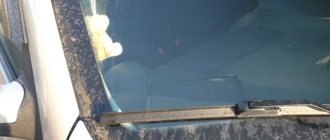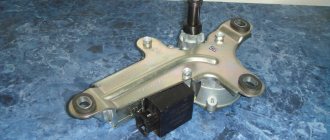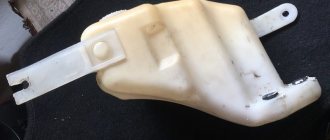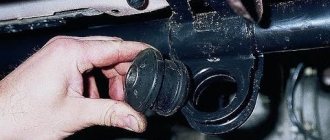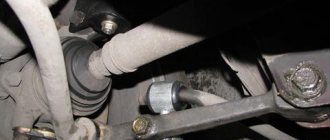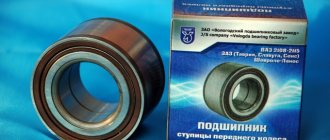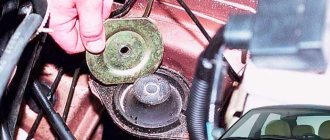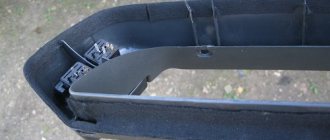The wiper trapezoid is a mechanism for transmitting force from the windshield wiper motor to the wiper arms. In this case, the mechanism during operation:
- gradually wears out;
- trapezoid hinges become clogged with dirt;
- The grease is gradually washed out of the joints.
As a result, high loads on the wiper motor disable the motor, the driver is faced with poor quality of windshield cleaning, extraneous noise appears during wiper operation, etc. The solution in such a situation is to repair the trapezoid or replace the wiper trapezoid. Read more in our article.
Do-it-yourself repair and replacement of the windshield wiper trapezoid
The safety of the driver and the people in the car with him when driving in bad weather depends on the cleanliness of the windshield. The glass surface is cleaned by a cleaner, so its serviceability will determine how clean the glass will be. The article discusses the windshield wiper trapezoid (WW): the device, signs and methods of malfunctions, and instructions for replacement are given.
Characteristics of the windshield wiper trapezoid
The trapezoid is one of the most important elements of the windshield wiper mechanism. The operation of the entire unit depends on its serviceability. To maintain the functionality of the vehicle, you need to know what its device is and how it works.
Purpose and device
The trapezoid is the element of the glass cleaner that translates the rotational movements of the electric motor shaft into the movements of the wipers. Therefore, it is one of the components of safety in bad weather conditions.
Disassembled device
The design of the vehicle is almost the same for all car models. The differences lie in the shape, size of its components and methods of fastening.
The device consists of the following parts:
To reduce friction losses and energy consumption, the device connections are made of polyformaldehyde. It has a low coefficient of friction and high wear resistance. Metal parts are protected from corrosion processes and friction by a galvanic layer.
The principle of operation is as follows: the motor drives the finger, which causes the trapezoid to move. The shafts are connected to the gearbox using rods, performing oscillatory movements. The result of this work is the movement of the wiper brushes from side to side, due to which the glass surface is cleaned.
Symptoms of malfunctions and ways to eliminate them
In order for the windshield wiper trapezoid to be operational, you need to know the signs of its malfunction and try to eliminate them as soon as they are detected.
Another sign of a mechanism malfunction is intermittent, irregular movement of the brushes. The reason for this is oxidation on the drives of the drivers located in the vehicle bushings. If you do not pay attention to the oxide, the electric motor may fail, since a large load is placed on it.
Windshield wiper motor
If the windshield wiper trapezoid bushings are worn out, play in the windshield wiper arms appears. The weakening of the pressure in the assembly leads to the fact that the wiper does not fit tightly to the glass and cannot cope with the flow of rain. If the linkage of the windshield wiper is faulty, the movement of the blades becomes difficult.
The cause of the malfunction may be wear of individual parts. In this case, you need to remove, disassemble the mechanism and replace worn elements.
Why does the windshield wiper trapezoid fail?
The main cause of all problems associated with the trapezoid is the location of the mechanism. The wiper motor and trapezoid are located directly under the glass.
Dirt, small abrasive particles, water and washer fluid constantly accumulate in this area.
This leads to wear at the moving joints and loss of lubricant. Active wear of the plastic bushings of the hinges is observed, backlashes appear, resistance noticeably increases during operation and the load on the motor increases. In such conditions, the trapezoid for the wipers and the motor quickly fail.
As a rule, the VAZ 2110 trapezoid requires revision every 2 years. Such an inspection should mean cleaning the trapezoid from dirt and additional lubrication. If this is not done, after 5-6 years the trapezoid will need to be replaced or repaired (a trapezoid repair kit is used).
In what cases does a part need to be replaced?
If there are signs of a vehicle malfunction, in order to figure it out, repair or replacement is necessary, diagnostics should be carried out. If it is possible to repair the windshield wiper trapezoid, then you should replace broken or worn parts (video author - GARAj Alex Fierro).
If it is customary to completely change the device, then when purchasing a new product you should pay attention to the mounting method and size. Trapezoids may differ in the plug for connecting to the electric motor and the size of the leads.
One conclusion can be drawn: you should buy original products designed specifically for your car model.
Instructions for replacing the trapezoid
Replacing the windshield wiper arm can be done by yourself as it is a simple process. The entire mechanism needs to be replaced.
Before work, you should prepare the following tools and materials:
Photo gallery “Step-by-step replacement of the windshield wiper trapezoid”
To do this, follow these steps:
- First of all, you need to turn off the power to the car by removing the “-” terminal from the battery.
- The next step is to dismantle the old trapezoid. To do this, you need to remove the windshield trim and the expansion tank.
- Then you need to disconnect the wiper motor connector.
- Next, you need to unscrew the left and right nuts securing the glass wiper, remove the wipers, all plugs and fasteners using a Phillips screwdriver. The plastic parts on the casings also need to be removed.
- Then you need to unscrew the fastening nuts of the electric motor bracket to the car body, as well as the fasteners connecting the trapezoid to the motor. After this, you can dismantle the motor.
- After dismantling the electric motor, the vehicle can be removed.
- Before installation, the new vehicle must be assembled, since it is sold disassembled.
- After installing a new product, the mechanism should be assembled in the reverse order.
When the assembly is completed, you need to adjust the brushes and lubricate all components and parts of the graphite lubrication mechanism.
The procedure for repairing a windshield wiper is removing and installing a gearbox with a motor.
Rubber bands for wiper blades
The procedure for repairing a windshield wiper is removal and installation.
Repair of VAZ 2101 windshield wiper, disassembly and assembly
The procedure for repairing the VAZ 2101 windshield wiper
- unscrew the wiper blades with holders;
- disconnect the wires from the windshield wiper motor and the terminals from the battery;
- remove the equalizers by first unscrewing the nuts securing the lever fittings;
- dismantle the windshield wiper assembly, first unscrewing the nuts of the motor bracket;
- Perhaps a workbench will help you to remove the gearmotor from the mounting bracket, and then disassemble the lever drive;
- Installation of the windshield wiper after repair is carried out in the reverse order.
After you have repaired the windshield wiper, you need to connect it so that it makes several working cycles. The wiper blades must be installed (in the lower position) – 50 mm from the glass seal. After complete assembly, we check what we have achieved and, if necessary, make adjustments.
Below we will look at how to disassemble and then assemble an electric windshield wiper motor and its gearbox.
Replacing the windshield wiper trapezoid
Windshield wipers prevent snow, rain, or dirt from sticking to your glass. They include a trapezoid, which can fail, so it is necessary to detect the breakdown in time and repair it.
It is almost impossible to imagine a production car without a windshield wiper, and its breakdown in bad weather conditions can lead to an accident. As a rule, moving mechanisms fail. Let's consider what frequent breakdowns are observed, the principle of their elimination and replacement of the trapezoid.
Repair kit for windshield wiper trapezoid Lada Kalina
Some owners of budget Lada Kalina models have problems with the windshield wiper trapezoid due to its unexpected failure. This type of malfunction has become widespread, so we cannot ignore this issue, because the situation when the wipers stop functioning in the rain is not the most pleasant. And the windshield wiper needs repair.
We recommend: The tachometer needle jumps
What are the causes of breakdowns?
The most likely factor causing the wipers to stop is the blown working element in the fuse. Eliminating this malfunction involves performing the simplest action - replacing the fuse link. It is located in the corresponding mounting block, located on the left side of the steering column. It will be useful to stock up on a fuse diagram, which will help you easily find the insert we need.
When the purifiers stopped functioning intermittently, the control relay most likely became unusable. This component is also located in the previously designated block. When a relay fails, it is replaced with a new analogue. However, we note that according to numerous reviews from owners of domestic small cars, certain statistics have been formed indicating the small number of cases of breakdowns of this kind.
The most common cause is the destruction of bushings. They are made of plastic, so they do not boast a long service life, which reaches a maximum of three years.
The process of destruction of elements is primarily influenced by the quality indicator of the material.
Here, the only effective measure is replacement, and to carry it out you should acquire a repair kit, which is available at a specialized retailer. In this case, the trapezoid is replaced.
If the owner of a Lada Kalina discovers that the wiper drive is not working, this indicates that the unit’s motor has failed. In order to verify this fact, you will need to make sure that voltage is supplied to the motor contacts from the on-board network. This procedure is easily performed using a regular tester. If there is power, then we definitely change the motor.
How to troubleshoot purifier malfunctions yourself?
When the owner of LADA Kalina turns on the windshield wiper drive, the motor works, but the wipers refuse to move, then the bushings will have to be replaced. For this purpose, the trapezoid of the wipers is dismantled, which is covered by a decorative plastic panel. The location of the unit (trapezium) is directly under the windshield. Repair of the windshield wiper is carried out using the windshield wiper trapezoid repair kit in the following order:
- unscrew the fasteners of the brushes and remove them together with the leads;
- then we dismantle the decorative protection panel, for which we stock up on a Torx T20 wrench;
- we move on to removing the trapezoid itself, which is held on the frontal body element by means of a nut and a pair of bolts, using, if necessary, a repair kit for the windshield wiper trapezoid;
- Next, you will need to disconnect the supply lines of the unit from the battery;
- Now you can remove the assembly.
If you resort to replacing the bushings without removing the trapezoid, you create a risk of deformation of the hinges, which will lead to incorrect operation of the brushes. A destroyed bushing will immediately give itself away, so we boldly proceed to the “operation”. The element is removed using wire cutters.
Before installing the new bushing along with the lock washer, you will need to preheat it in boiling water, which will allow you to easily slide the specified element onto the hinge.
Also, before installing the ring, lubricate the bushing with a suitable substance, for example, lithol.
The entire list of manipulations will take no more than 1 hour
In cases where the central bushing breaks, the entire mechanism will have to be replaced. This work is not capable of creating difficulties, so we unscrew the previously indicated list of fasteners and dismantle the assembly, and install a new mechanism in its place.
Such a replacement will be more expensive compared to the usual replacement of bushings, but this option is more reliable. The owners of LADA Kalina assure that after replacing the bushings, the mechanism is able to provide a service life of at least two years.
Here the choice remains with the owner, which method to lean towards in a given situation.
When is it necessary to replace windshield wipers in Kalina?
Over time, owners of practical Lada Kalinas notice the appearance of brush marks on the surface of the windshield. Such “artifacts” create an obstacle to good visibility.
In this situation, the designated components will need to be replaced, and the trapezoid will likely need to be replaced.
Many experienced owners advise purchasing frameless brushes, which, in their opinion, are able to “bravely” withstand temperature changes and can demonstrate a relatively longer service life of approximately 1.5 million cycles.
Before replacing, you should understand the required size of the products. For Lada Kalina, you should purchase a driver's side brush with a length of 600 mm, and for the glass area opposite the passenger - 400 mm. For stern glass, the brush has a standard parameter of 360 mm. This wiper needs to be replaced much less frequently, since the intensity of its work is significantly lower compared to the front components.
What is included in the Grant standard package?
Lada Granta standard equipment what is included
Photo Lada Granta luxury photo
Let's sum it up
Such an important process as replacing wipers, or when changing the windshield wiper trapezoid on a LADA Kalina car, is a very simple undertaking. There is no need for special devices or fancy tools. The brushes are removed by opening the locks.
Repairing or replacing a part such as a windshield wiper trapezium appears as a more responsible job, but it is not capable of causing difficulties for an inexperienced owner of a Lada Kalina. In such situations, do not hesitate to take action.
Signs of trouble
In order to fix the breakdown in time, you need to know the first signs of problems associated with the windshield wiper mechanism, namely the trapezoid. It's not that difficult to spot them. First of all, problems with the trapezoid may be indicated by poor performance of the wipers. For example, they may move out of sync or too slowly. Also, intermittent movements on the glass or a characteristic creaking sound can be a signal of problems with the trapezoid.
However, these signs may indicate problems with the wipers or other mechanisms. In order to find out the true cause of the breakdown, you must fully diagnose the system.
Often, problems with wipers lead to wear on the trapezoid bushings. A clear sign of this problem may be the formation of backlash. The main reason for this is the formation of oxide, which subsequently causes the electric motor to malfunction.
In any case, these signs indicate the need to repair the trapezoid mechanism. Depending on the stage of the device failure, you can either repair the problematic elements or completely replace the device.
Wiper design
Main components of the windshield wiper:
- Control system.
- Brush and leash.
- Trapezoid.
- Levers.
- Worm mechanism.
- Electric motor.
- Gearbox.
In order for the windshield wiper blades to move smoothly across the glass, sufficient force must be transmitted to the driver. This is achieved through the operation of an electric motor connected to a gearbox, which has a worm gear. Since the system has a gearbox, it is possible to reduce the shaft speed and increase the amount of force transmitted to the trapezoid. The trapezoid synchronizes the movements of both brushes.
Repair and replacement of trapezoid
Before you start work, you should prepare all the necessary tools, namely a Phillips and flathead screwdriver, keys, and lubricant.
In case of complete replacement of the trapezoid, it is necessary to carefully select a new device. It is better to choose a branded device, since the trapezoid itself of different models has a similar appearance, however, the mounting methods or dimensions may differ significantly. It is best to use trapezoids from well-known companies Original Equipment Manufacturer (OEM), Fabryka Samochod?w Osobowych (FSO) and GENERAL MOTORS (GM), which are famous for producing quality parts.
The next step is to disconnect the trapezoid from the motor. This stage can be difficult, since the nuts are often very tightly fastened, and it is not always possible to unscrew them with a simple wrench. In this case, a drill, crowbar or any other tool capable of removing the nuts will do. Once you have managed to disconnect them, remove the motor and take out the trapeze.
Before installing a new part, you should check its integrity. After this, you should assemble the entire structure in reverse order. After securing and screwing in all the necessary parts, it is necessary to check the presence of lubricant. If it is missing, you need to lubricate the parts that rub against each other. Basically, a graphite-based lubricant is suitable for this, which is durable and protects parts from rust and overheating. Another popular type of lubricant is lithol. However, it is better not to use it, since the lubricant is quite unstable and under low temperature conditions it partially loses its original properties.
In the case of repairing a single part, there is no need to completely disassemble the entire trapezoid mechanism. In this case, you only need to replace the worn bushings. To do this, unscrew the nuts and other fasteners. After you have removed the worn bushings, you should clean the axle from adhering dust and dirt. There may also be rust on it that needs to be removed. Then you need to secure the new aluminum bushings so that they slide in easily and smoothly. After everything, lubricate the necessary parts with graphite lubricant and reassemble the structure in the reverse order.
Come on, get moving: why the wipers stop working and how to fix a trapeze
Just about simple things
The trapezoid of the wipers is the same mechanism due to which the rotational movement of the brush drive motor is converted into their translational movement. At first glance, there is nothing complicated about the trapezoid: several rods, articulated joints and bushings. Moreover, it is not clear what could break there. Usually nothing breaks, it’s just that over time the connections become clogged with dirt, corrode and lose mobility. And in the case of such arthritis in the trapezius, the wipers first walk more slowly, then they simply stand up. There is another scenario: the engine is on fire. It’s better not to wait for this, but to start repairing. Depending on their greed, the services ask for different amounts of money for this work. Some are ready to do it for five hundred rubles (which is rare), others – for one and a half thousand (which is more common). Not robbery, of course, but many will most likely want to tinker with their favorite car themselves. Therefore, we will tell you how to do this. At the end there will be a bonus for those who read the instructions after they have already broken everything. The work has one significant advantage: it does not require complex “devices”, torque wrenches, a lift or a synchrophasotron. For example, we did everything with an ordinary set of tools from a well-known store for 600 rubles. In addition to a screwdriver, keys, hammer and Torx, you will also need graphite lubricant and some kind of liquid wrench like WD40, Valera, Runway or any other - everything is up to your taste.
Almost all trapezoids are constructed the same way and sour in the same place. We will take the Ford Focus as an example, the trapezoid of which has stubbornly turned sour at the most inopportune moment for three generations in a row. Stability, damn it. There is also a whole list of cars in which the trapezoid sours more often than we would like: from the Mercedes W204 to the Hyundai Elantra IV and any Kia Ceed. The principle will be the same everywhere. Therefore, we will tell you how to do everything on a Ford, and if you are lucky enough to buy another car, just carefully project this guide onto your car.
Bolts, latches and flexible pins
First, remove the wiper arms. Everything is simple here: remove the protective caps, unscrew the nuts and pull them off their axles. There is nothing complicated here.
Then we move on to dismantling the plastic frill. Focus has two parts – upper and lower. The top half is attached with simple latches that can be easily moved with a screwdriver. The main thing is to hold them tightly with your fingers, because at the last moment the latch may fly somewhere into the engine compartment. We put the removed latches together with the nuts and washers from the wiper arms, pull out the rubber seal from the groove and remove half of the frill. And again, all this is not difficult to do.
At this stage, the trapezoid is already clearly visible. Some people are already stopping here and taking her out of the car. To be honest, this is not very easy, so let's work with the screwdriver a little more and disassemble the car a little more. It is enough to unscrew just two bolts with Torx heads to remove the lower part of the frill. But access to the trapezoid will be downright chic. Therefore, we spend a couple more minutes and remove this part.
1 / 3
2 / 3
3 / 3
You just have to do this carefully: Ford engineers (damn them for just one hood lock!) for some reason made the windshield heating two-zone, so the connectors for heating the glass halves are visible on the right and left under the frill. If you swing the removed plastic like Taras Bulba with a saber, you can damage the cables.
So now we can see the trapezoid in its entirety.
In our case, the trapezoid is secured with three bolts, which we unscrew. Now you can pull it out, but again, very carefully. There is nothing surprising in the fact that there are wires that connect to the trapezoid motor, which do not need to be torn. You need to remove the terminal, but this is easier to do if you slightly pull the entire trapezoid into the light of day. The length of the wires allows this, and Ford engineers (let them be empty for all the electrics!) placed the connector latch at the bottom. So it is very, very difficult to hold it in place. Therefore, we pull the trapezoid out a little, then remove the terminal.
That's it, the trapeze is in our hands. You can breathe out. But not much, because the most difficult thing awaits us ahead.
A little strength and a lot of skill
Trapezium hinge joints are usually made from polyformaldehyde. It is such a durable material with very low friction. For example, recently mediators for guitarists have often been made from it. And for machines - these are the connections where the friction force should be minimal and wear resistance should be high. It also does not rust, which is also good. Due to all these factors, we can say that it is almost pointless to disassemble the hinges: nothing will turn sour there, and breaking the connection for the sake of curiosity is harmful. Well, if you do take it apart, you can remove the dirt from there. This will not be superfluous.
Now let's move on to our main enemy. The trapezoid sours precisely in these places: these are the bushings with the axles of the leads. No matter how much they try to protect them with all sorts of caps and rings, water still gets inside and does its dirty deed.
The axles must be pulled out of the bushings. To do this, first remove the protective cap and retaining ring. I won’t warn you about the meanness of the latter: everyone knows that it can fly anywhere. But with some skill it is not difficult to remove.
And now the dancing with the tambourine begins. More precisely, with a hammer, a Vedashka and swear words. If the trapezoid has not yet completely soured and the wipers are at least moving somehow, it will be much easier to knock out the axles. Otherwise it will be difficult. In addition, you will have to knock with a hammer on the end on which the thread is cut for the wipers themselves. If you do this with fanaticism, then you won’t be able to put the wiper in its place. And without fanaticism, it is difficult to knock the axle out of the bushing.
Liquid keys will help here (but this is not certain). For those who have not used them before, I will give one piece of advice: it is useless to spray on the axle and hit it with a hammer at the same time. First you need to splash the soured compound, then wait five to ten minutes, then you can knock with a hammer. If the axis has moved even slightly, the procedure should be repeated. There is no such thing as an extra “Vedashka”.
So, let's say that we managed to knock out the axle. All that remains is to lubricate it. Many people mistakenly believe that the same WD-40 softens corrosion so well, removes moisture and works other miracles. And also - that the parts on which it fell never rust. This is wrong. As long as this miracle liquid has not dried, the axle will even rotate quite well in its bushing due to the small amount of oil in the “wheel drive”. But it won’t last long, as is the case with any other “liquid key”. They are poor lubricants, so as soon as the axle dries, it needs to be lubricated. Graphite grease is best. Well, when the axis is generously lubricated, everything can be assembled in reverse order. Anyone who has taken it apart once can always put it back together.
Only one point is important: before installation, it is advisable to place the trapezoid in the position in which it once soured. Otherwise, there is a non-illusory chance that after the first turn on, the revived mechanism will grind both the wipers and itself.
Promised bonus
Unfortunately, for very strong and stubborn people, repairing a trapezoid often ends in its complete destruction with the help of a hammer and their own stupidity. The platform on which the motor stands is often made of a rather fragile alloy that does not withstand the tenacity of the hammer owner. It breaks, and in this case no miracles like Suprotec, blue electrical tape and dimexide will help. There is only one way out - buy another trapeze. New, original, analogue, disassembled, Chinese - a matter of money, preference or religion, the choice is yours. The main thing is that free work will result in spending on new spare parts and unnecessary actions associated with rearranging the engine. You can, of course, buy it assembled, but it will be noticeably more expensive.
And when buying a trapezoid from disassembly, you need to check it thoroughly. In the best case, it will also be sour, and it will have to be disassembled and lubricated in the same way. At worst, it can be broken: over time, the polyformaldehyde connections wear out and begin to play. And it is no longer possible to fight this.
Repair cost
You can repair or replace the trapezoid at any car service center. However, the price for this service is quite high. In case of self-repair, all parts can be found in any automobile store. Trapezoid parts are sold disassembled, and their price ranges from $40-70. The cost of graphite lubricant is approximately $10-20.
Video about replacing the VAZ 2110 windshield wiper trapezoid:
Removing and installing the wiper motor and trapezoid
I’ll say right away that in all the years of ownership of the “classic” by both me and my father, I don’t remember a time when I had to remove the windshield wiper trapezoid together with the motor. It turns out that in my case this mechanism was always quite reliable and never needed repair or replacement. If you are a little less fortunate, then using my VAZ 2106 as an example, I will try to describe the procedure for performing the procedure. And before that, as usual, I will give a list of necessary tools for repairs:
- Open-end or combination wrench 22
- 10mm socket
- Ratchet handle with extension
The procedure for removing wipers on a “classic”
Using a 10 mm wrench or a socket with a wrench, unscrew one nut securing each of the wipers:
Then we remove the levers together with the windshield wipers, tugging them a little so that they come off the slots:
Now take a 22mm wrench and use it to unscrew the trapezoid mount from above:
And take out the plastic pads with washers, which are visible in the picture below:
Features of removing the windshield wiper motor and trapezoid on a VAZ 2106
The first step is to disconnect the power plug from the wiper motor. To do this, disconnect it by pulling the ends to the sides with a little force:
Now you need to slightly lift the rubber of the hood seal from one edge, as is clearly shown in the photo below:
And after that we remove the wire with the plug from the slot in the body of the VAZ 2106:
Now you can unscrew the mount of the motor itself by slightly lifting the protective cover:
Then press on the slotted pins so that they fall inward. And we try to remove the windshield wiper motor, turning it from side to side to find the optimal position for removal:
Everything is ready; if necessary, we replace the entire mechanism along with the trapezoid. Again, I repeat, very few VAZ 2106 will have to undergo this procedure, since the entire structure is quite reliable.
What is a windshield wiper trapezoid?
Windshield wiper trapezoid - a windshield wiper drive, a system of rods and levers that provides reciprocating movements of the wiper blades on the windshield or tailgate glass of vehicles.
Cars, buses, tractors and other equipment must have a windshield wiper - an auxiliary system that cleans the windshield of water and dirt. Modern systems are electrically driven, and the transmission of force from the electric motor to the brushes is carried out using a system of rods and levers laid under the glass - a windshield wiper trapezoid.
Windshield wipers - taking care of cleanliness
Today, personal transport will not surprise anyone, and the equipment of modern models is aimed at ensuring adequate safety for road users. One of the main elements responsible for our smooth movement are car windshield wipers. They ensure the cleanliness of the windshield and rear glass during precipitation, remove drops of moisture, dirt, traces of insects and other debris.
But can we really assess the situation on the road when the glass is not sufficiently cleaned, everything is stained, and we constantly have to strain our eyes? It follows from this that the high-quality work of wipers also has a direct impact on our health. But now we are not interested in the node as a whole. We'll talk about the trapezoid. It is responsible for converting the rotational impulse of the motor into the translational movement of the windshield wiper blades.
The trapezoid is a rather complex electromechanical device and often fails. The main elements of the purifier are the body, rods, shafts and motor. The components of the gearbox are pins and hinges. The principle of operation is as follows: the windshield wiper motor creates a rotational movement of the finger and sets the trapezoid itself in motion. Rods connect the shafts to the gearbox and transmit oscillatory movements. As a result, the wiper blades move from side to side and clean the glass of dirt.
Types, design and operating principle of windshield wiper trapezoid
First of all, all trapezoids can be divided into three types according to the number of brushes:
- For single blade wipers;
- For double blade wipers;
- For three-blade windshield wipers.
In this case, the drive of one brush cannot be called a trapezoid, since in most cases it is built only on an electric motor with a gearbox without additional rods or with one rod. And two- and three-brush trapezoids have a fundamentally identical design and differ only in the number of rods.
In turn, two- and three-brush trapezoids can be divided into two types according to the location of the electric motor connection:
- Symmetrical - the electric motor is located in the center of the trapezoid (between the brushes), ensuring the movement of both brush rods at once;
- Asymmetrical (asymmetrical) - the electric motor is located behind the trapezoid, providing its drive with additional lateral traction.
Today, asymmetrical trapezoids are the most common; they have a fairly simple structure. In the general case, the basis of the design is made up of two hinged rods; in the hinge between the rods and at the end of one of them, leashes are installed - small length levers, rigidly connected to the rollers of the brush levers. Moreover, the middle leash can be installed directly into the hinged connection of two rods (in this case, two rods and a leash come out from one point), or it can connect the rods with two hinges, and carry a roller in the middle part. In both cases, the leads are located perpendicular to the rods, which ensures their deflection during the reciprocating movement of the rods.
The rollers are made in the form of short steel rods, on the top of which a thread is cut or slots are provided for a rigid fit of the windshield wiper blade arms. Typically, the rollers are located in plain bearings, which, in turn, are held by brackets with holes for fasteners. With the free end of the second rod, the trapezoid is connected to the electric motor gearbox, which has the simplest design - in the form of a crank directly located on the motor shaft, or mounted on the gear of a reduction worm gear. The electric motor and gearbox are assembled into a single unit, which can also contain a limit switch that ensures that the blades stop in a certain position when the windshield wiper is turned off.
Rods, drivers, rollers and brackets of the mechanism are made by stamping from sheet steel or by bending tubular blanks that have high bending rigidity. The hinges are made on the basis of rivets or pistons; plastic bushings and protective caps are installed at the hinge joints; additional lubrication may also be provided. The holes for the hinges in the leads are often made oval to ensure the necessary trajectory of movement of the brushes.
The windshield wiper drive works as follows. When the windshield wiper is turned on, the crank converts the rotational movement of the electric motor shaft into the reciprocating movement of the trapezoid rods, they deviate from their average position to the right and left, and through the leads they force the rollers to rotate at a certain angle - all this leads to characteristic vibrations of the levers and the brushes located on them.
The trapezoids of three-blade windshield wipers are designed in a similar way, only a third rod with a leash is added to them; the operation of such a system is no different from that just described.
Symmetrical trapezoids also represent a system of two hinged rods and leads, however, the leads are located at opposite ends of the rods, and an additional leash or lever is installed in the hinge between the rods for connection to the electric motor gearbox. To increase rigidity and simplify installation, a bracket can be inserted into such a trapezoid - a pipe connecting the brush leads, in the central part of which there can be a platform for mounting an electric motor with a gearbox. This system does not require separate fastening of leads or rollers, which increases its convenience and reliability compared to other types of trapezoids.
Windshield wiper trapezoids can be located under or above the windshield in a special niche (compartment) formed by body parts. The brackets with the rollers of the brush levers are mounted on the body (flush) using two or three screws (or bolts), and the leads of the rollers are usually sealed with rubber rings or protective caps/covers. The electric motor with gearbox is mounted directly on the body part or on the bracket included with the trapezoid. Single-blade tailgate glass wipers are installed in the same way.
How to remove the windshield wiper trapezoid
To remove the trapezoid you will need:
- key to 10;
- thin flat screwdriver;
- crosshead screwdriver.
First of all, you need to remove the wipers. To do this, you need to remove the plastic pads and unscrew the nuts with which they are attached to the trapezoid studs. Then unscrew the screws and side fastenings of the protective casing (jabot) and remove it. If the fasteners do not come out, treat with WD-40. Before removing the casing, make sure to remove all screws, bolts and nuts. If the cover does not come off, look for a fastener that you did not remove. Lifting the frill, disconnect the washer fluid supply tube from the tee, and then move the casing to the side.
Remove the belt that supports the radiator tank and move the tank to the side. Then pull out the partition (sound insulation), which is located behind the tank. Don't forget to remove the washer fluid supply tube from it. Disconnect the electric motor power connectors. After this, unscrew the bolts securing the trapezoid and electric motor. To remove the trapezoid, you must either struggle for a long time, coming up with various options, or place a thin flat-head screwdriver under the far end (relative to the motor) of the lower rod of the trapezoid and pull out the entire structure as if on a slide. You can also turn the left edge of the trapezoid clockwise and pull it out, then remove the engine.
Symptoms of a malfunction and how to fix them
A trapezoid is an electromechanical device whose purpose is to convert the rotational impulse of the engine into forward-return movements of the wipers.
The principle of operation is simple: a motor uses a finger to activate the trapezoid mechanism. The rods connecting the shafts and the gearbox convert rotary motion into translational motion and activate the wipers.
Signs of a faulty windshield wiper trapezoid:
- the appearance of extraneous noise during operation;
- loose fit of the brush to the glass. Over time, the gap will increase, snow/water will no longer be cleared off at all;
- windshield wiper blades do not cope with heavy rainfall; the trajectory of the wipers changes (they go too low or too high, leaving uncleaned areas);
- the mechanism interferes with opening/closing the hood and scratches the paintwork.
There are two ways to fix the problem - replacing the wiper trapezium or repairing it.
How to change a windshield wiper trapezoid
It is necessary to select a new spare part suitable for a specific vehicle and prepare the tool. You will need several different wrenches, a flathead and a shaped screwdriver. Depending on the make/model of the machine, the process of disassembling and reassembling the mechanism may differ.
Replacement is carried out according to the following algorithm:
- The wiper arms are unscrewed.
- The wipers themselves are removable.
- The retaining ring and casing are dismantled.
- The rod is disconnected from the drive joint of the mini-motor.
- The fastening elements of the brackets are unscrewed.
- The trapezoid is removed.
- The windshield wiper trapezoid is being replaced with a new one.
- Reassembly is carried out in reverse order.
Compatibility of VAZ 2110 windshield wiper trapezoids and its replacement
| It’s unpleasant when problems with the windshield wiper appear at the most opportune moment, for example, the wipers refuse to work, their movements are difficult, or the blades scratch the car’s windshield. You may have to change the purifier trapezoid assembly, but which one should you install to replace the old one? |
- 2110-5205015
- 2110-5205015-01
- 2110-5205015-11
- 2110-5205015-20
- 2110-5205015-21
Chassis deviceAnti-roll bar Anti-roll barSelf-propelled chassisSelf-propelled chassisCar chassis device, purposeCar chassis device, purposeCar chassis device Chassis device
Replacing the windshield wiper trapezoid 2110
- Disconnect the wiper gear motor connector.
- Unscrew the nut securing the trapezium to the body on the left.
- Unscrew the nut on the right securing the trapezium to the body.
- Unscrew the bolt securing the gearmotor bracket.
xn--2111-43da1a8c.xn--p1ai
How to repair a trapezoid
Repairs are rarely carried out when bushings break.
It is difficult to select them; it is easier to change the entire mechanism assembly. However, repair kits are available for some cars.
Spare parts can be plastic and aluminum.
The latter are more reliable, but they cannot always be found. And they are not suitable for every mechanism.
Repairs are carried out as follows:
- The mechanism is disassembled (as when replacing), the trapezoid is removed.
- Old parts are removed.
- The worn bushings are replaced with new ones from the repair kit.
- The mechanism is assembled in reverse order.
For what reasons might difficulties arise?
Carrying out the process itself is not difficult, but sometimes you still have to face problems and solve them:
- If a repair kit is not provided, the bushings are selected separately, but may not fit. In this case, they can be drilled out, making sure that the drill does not heat up too much and does not deform the plastic part.
- It is advisable to clean the surface of aluminum products, as there are often unevenness and roughness on it - this interferes with the installation of the part.
- The most common question that arises is how to remove the windshield wiper trapezium. The fact is that fasteners tend to “sour” without giving in to the key. In this case, you will have to resort to using a grinder or drill. At home, craftsmen often resort to using a hammer and chisel to cut off a tightly fixed bolt.
- Before installing a new trapezoid, its elements are inspected for lubrication. If it is missing, it is recommended to apply lithol or other lubricant to the mechanism components.
- When replacing the bushing with an aluminum one, it must also be lubricated.
- When purchasing an aluminum spare part, you should purchase four fastening elements (bolts, nuts) for it.
How to change the windshield wiper trapezoid quickly and efficiently? To do this, you will have to contact a car service. The technician will help determine the breakdown, advise which spare part to choose for a specific car and, most importantly, solve the problem with stuck bolts carefully, without the use of auxiliary tools, without causing serious damage. Any workshop has special solutions and devices to correctly solve the problem.
After installing a new trapezoid at a service center, you will not have skewed wipers, incorrectly adjusted position and other troubles that arise after amateur repairs.
Trapezium and its functions
Poor visibility on the road can cause an accident. If the glass is not clean enough, the driver strains his vision and soon loses concentration. This can lead to tragic consequences. Therefore, you should carefully monitor the performance of the windshield wipers and its components.
The device itself has a fairly simple design and consists of elements such as a gear motor, levers, an electric motor, a driver, a brush, a worm gear mechanism and a device control system. One of the important parts of this device is the trapezoid. Each brand of car has its own branded trapezoids. They are similar in design and differ only in size and mounting methods.
The work of the trapezoid is that it transmits the rotational motion of the gear motor to the wipers. An important fact is that the trapezoid ensures that the wipers move synchronously and efficiently clean the glass from dirt. The design of the trapezoid itself combines several elements, for example, a motor, rods, a body and a hinge.
Connecting parts for trapezoids are mainly made from a special plastic mass - polyformaldehyde. Thanks to this substance, the parts of the device do not overheat and do not rub, which in turn prolongs the life of the entire mechanism. Since the trapezoid contains metal elements, they are coated with a special galvanic method, which is based on electrolysis. This prevents corrosion of metal elements.
